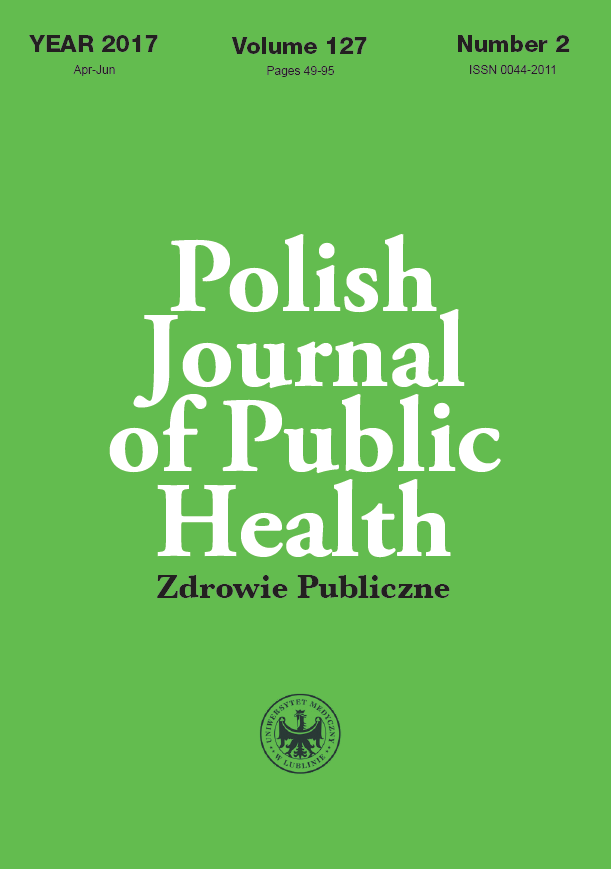Assessment of nutritional status and dietary habits of children attendingthe nursery in Sanok
DOI:
https://doi.org/10.1515/pjph-2017-0019Słowa kluczowe:
nutritional status, feeding of infants, complementary foods, allergenic foodsAbstrakt
Introduction. The state of human health largely depends on environmental factors. Nutrition as one of them is important in the earliest stages of child development. By following the principles of rational nutrition, we provide the child the necessary components that determine its growth and development. By analyzing the relationship between nutrition and health three elements should be taken into account: selection of food, compliance with dietary guidelines and an assessment of the effects of nutrition.
Aim. The research aimed at the assessment of nutritional status and dietary habits of children attending the nursery.
Material and methods. The study was conducted among 92 healthy children aged 10-55 months attending two nurseries in the town of Sanok. In all the children, body mass and height were measured and the values obtained were related to the percentile charts. There was also an original questionnaire survey performed addressed to mothers of the children. It provided information on the diets of infants and introducing new complementary products to the diet of children in the first year of life. The results were compared with the nutritional standards for children fed both naturally and artificially.
Results and conclusions. While assessing the nutritional status of children, it was found that incorrect body mass concerned often overweight and obesity. Mothers too early stopped breast-feeding and introduced formulas to the diet of children. The main food product that caused allergic symptoms of children was cow’s milk and its products. Most mothers preparing meals for the children used the prepared food products for infants. On the basis of the obtained results it can be concluded that the introduction of complementary food into the diet of infants in the majority did not meet current dietary recommendations in 2007. There is a need to take preventive measures carried out by medical personnel addressed to parents/carers on the proper nutrition of their children in the first years of life.
Bibliografia
1. Socha J. Żywienie, a rozwój dziecka w pierwszym roku życia. Nowa Pediatr. 2002;2(29):96-102.
2. Matusik P, Małecka-Tendera E, Nowak A. Metody stosowane w praktyce pediatrycznej do oceny stopnia odżywienia dzieci. Endokrynol Otyłość. 2005;2(1):6-11.
3. Palczewska I, Szilagyi-Pągowska I. ABC zabiegów diagnostycznych i leczniczych w pediatrii. Ocena rozwoju somatycznego dzieci i młodzieży. Med Prakt Pediatr. 2002;3(21):140-6.
4. Szilagyi-Pągowska I. Auksjologia. Medycyna Praktyczna Pediatria. 2002;2(20):127-38.
5. Gnyś I. Najczęstsze błędy żywieniowe. In: M. Krawczyński (ed). Żywienie dzieci w zdrowiu i chorobie. Kraków: Wydawnictwo HELPMED; 2008. p. 61-2.
6. Jopkiewicz A, Suliga E. Biomedyczne podstawy rozwoju i wychowania. Radom: Wyd. Naukowe, Instytut Eksploatacji-Państwowy Instytut Badawczy; 2008. p. 47-50.
7. Łoś-Rycharska E, Niecławska A. Wpływ wybranych elementów żywienia dzieci w wieku niemowlęcym na wybrane cechy ich żywienia w okresie poniemowlęcym i przedszkolnym. Pediatr Współcz. 2010;12:2.
8. Socha J, Socha P, Weker H. Żywienie dzieci, a zdrowie wczoraj, dziś i jutro. Pediatr Współcz. 2010;12(1):34-7.
9. Czerwionka-Szaflarska M. Karmienie dzieci w poszczególnych okresach życia. In.: B. Pawlaczyk. Pielęgniarstwo pediatryczne. (ed). Warszawa: PZWL; 2012. p. 49-63.
10. Schneider MB, Brill SR. Otyłość u dzieci i młodzieży. Pediatr Dypl. 2006; 10(3):38-45.
11. Kardasz M, Pawłowska D. Wpływ otyłości w dzieciństwie na przyszłe życie człowieka dorosłego. Nowa Pediatr. 2008;2:35-40.
12. Książyk J. Żywienie, a odporność. Nowa Pediatr. 2002;3(30):204-8.
13. Adamska I, Świątek K, Czerwionka-Szaflarska M. Wpływ eliminacyjnej diety bezmlecznej na stan odżywienia dzieci do ukończenia drugiego roku życia. Pediatr Współcz. 2007; 9:1.
14. Gnyś I. Karmienie naturalne (piersią) noworodka i niemowlęcia. In: M. Krawczyński. (ed). Żywienie dzieci w zdrowiu i chorobie. Kraków: Wydawnictwo HELPMED; 2008. p. 72-82.
15. Łoś-Rycharska E, Adamska I, Swincow G. Średnia masa ciała dzieci w wieku do 18 miesiąca życia karmionych naturalnie i mlekiem modyfikowanym. Wiad Lek. 2006;LIX:5-6.
16. Łoś-Rycharska E, Kiejdo P, Czerwionka–Szaflarska M. Wpływ sposobu żywienia dzieci w wieku niemowlęcym na masę ich ciała w wieku przedszkolnym. Pol Merkuriusz Lek. 2007;XXII:130, 263.
17. Kowalewska-Kantecka B. Karmienie pokarmem matki złotym standardem żywienia noworodków i niemowląt. Pediatr Współcz. 2007;9(1):65-8.
18. Horvath A, Dziechciarz P. Żywienie dziecka w 1. roku życia. Stand Med Pediatr. 2010:563-6.
19. Cichy W. Mleko, jako najwartościowszy produkt spożywczy. In: M. Krawczyński (ed). Żywienie dzieci w zdrowiu i chorobie. Kraków: Wydawnictwo HELPMED; 2008. p. 24-29.
20. Szajewska H, Albrecht P, Dziechciarz P, Horvath A. Postępy w gastroenterologii i żywieniu dzieci w 2007 roku. Med Prakt Pediatr.2008;2 (56):51-64.
21. Borgna–Pignatti C, Marsella M. Pediatric Annals. Niedobór żelaza u niemowląt i dzieci. Med Prakt Pediatr. 2009; 3(63):51-63.
22. Gnyś I, Piątkowska P. Probiotyki i prebiotyki w żywieniu dzieci i młodzieży. In.: M. Krawczyński (ed). Żywienie dzieci w zdrowiu i chorobie. Kraków: Wydawnictwo HELPMED; 2008. p. 53-9.
23. Agostoni C, Axelsson I, Braegger C. Bakterie probiotyczne w produktach żywieniowych dla niemowląt. Komentarz Komitetu Żywienia Towarzystwa Gastroenterologii, Hepatologii i Żywienia Dzieci ESPGHAN. Med Prakt Pediatr. 2004;4(34):39-52 .
24. Adamska I, Czerwionka–Szaflarska M. Profilaktyka alergii pokarmowej u dzieci. Stand Med Pediatr. 2010;7:580-9.
25. Agostini C, Decsi T, Fewtrell M. Wprowadzanie pokarmów uzupełniających. Komentarz Komitetu ESPGHAN ds. Żywienia. Med Prakt Pediatr. 2008;3(57):45- 61.
26. Cichy W. Wprowadzanie tzw. pokarmów stałych. In: M. Krawczyński(ed). Żywienie dzieci w zdrowiu i chorobie. Kraków: Wydawnictwo HELPMED; 2008. p. 91-4.
27. Aktualne wytyczne w pediatrii. Zalecenia dotyczące żywienia dzieci zdrowych w pierwszym roku życia opracowane przez zespół ekspertów powołany przez konsultanta krajowego w dziedzinie pediatrii. Pediatr Dypl. Wyd. specjalne. 2008:8-15.
28. Książyk JB, Weker H.: Nowe zalecenia żywienia niemowląt w Polsce od roku 2007. Pediatr Współcz. 2007;9(4):292-7.
Pobrania
Opublikowane
Numer
Dział
Licencja
Prawa autorskie (c) 2018 Polish Journal of Public Health

Praca jest udostępniana na licencji Creative Commons Attribution-NonCommercial-NoDerivatives 3.0 Unported License.


